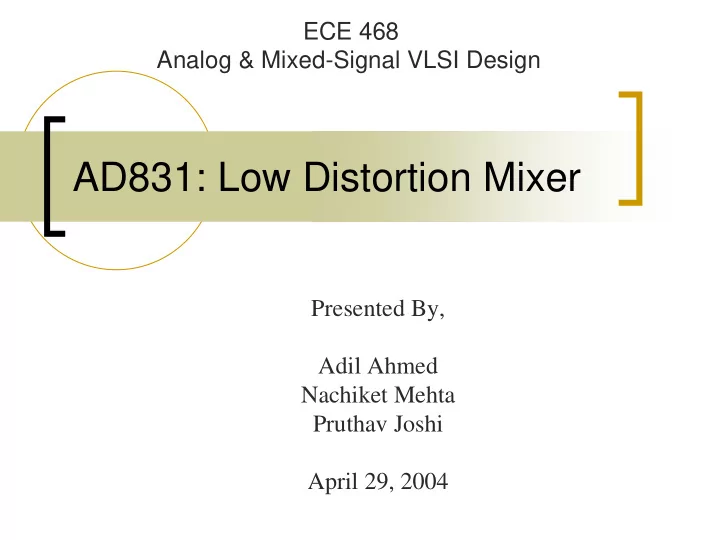

ECE 468 Analog & Mixed-Signal VLSI Design AD831: Low Distortion Mixer Presented By, Adil Ahmed Nachiket Mehta Pruthav Joshi April 29, 2004
Overview Mixer Fundamentals � Introduction to the Low � Distortion Mixer AD831 � Specifications � Pin Description � Table Theory of Operation � Schematics and � Simulation Applications � End Note �
Mixer Fundamentals Definition � A device in which two or more input signals are � combined to give a single output signal. Satellite communication systems � Non-linear device used to generate a replica of an � input signal at a higher or lower frequency Done by multiplying the input signal by a pure � tone of a different frequency (the "local oscillator" signal). Usually part of a frequency conversion process. For example, an LNB local oscillator signal at 10.6 GHz � mixed with incoming signal at 12 GHz would convert the input signal to an IF frequency of 12 -10.6 = 1.4 GHz.
Introduction to the AD831 [I] This is a low distortion, wide dynamic range, monolithic � mixer. The mixer includes an LO driver, a low-noise output � amplifier and also provides additional features. The AD831 improves system performance and reducing � system cost compared to passive mixers. Power Supply � RF, IF and LO ports are DC or AC coupled for ±5 V � AC coupled when using 9 V � The mixer's IF output is available as either a differential � current output or a single-ended voltage output
Introduction to the AD831 [II] A low noise amplifier provides a single-ended voltage � output. The gain is set by A single resistor connected between � pins OUT and FB. The amplifier's low dc offset allows its use in such direct- � coupled applications. The AD831 has no insertion loss and does not require � an external diplexer or passive termination. Power consumption. � Reduces power consumption. � A tradeoff between dynamic range and power � consumption.
Specifications I AD831 Mixer:
Specifications II AD831 Mixer:
Pin Description Table AD831 Mixer:
AD831 Mixer: Theory of Operation Consists of the following: � Mixer core � Limiting amplifier � Low noise output amplifier � Bias current � RF input is converted into differential currents by a highly � linear V/C converter Resulting currents drive differential pairs � LO input converts LO input into a square wave � Drives differential pairs and produces high level output � and a series of lower level outputs caused by odd harmonics of LO frequency mixing with RF input39 On-chip network supplies bias current to RF and LO inputs � (ac-coupled)
Full Schematic Diagram AD831 Mixer:
Bias Current Schematic
Current Mirror Schematic
Limiting Amplifier Schematic
Full System Schematic
Simulation of Schematic
Values 5.0 V/-5.0V -1.0 V 50 µA 1.0 V 1.0 V 1.0 V Input Values Input VP/VN BIAS LON RFN LOP RFP
References www.analog.com/UploadedFiles/Data � _Sheets/36203455769223AD831_c.p df Analog Design for CMOS VLSI � Systems by Franco Maloberti Analysis and Design of Analog � Integrated Circuits by Grey and Meyer
Recommend
More recommend